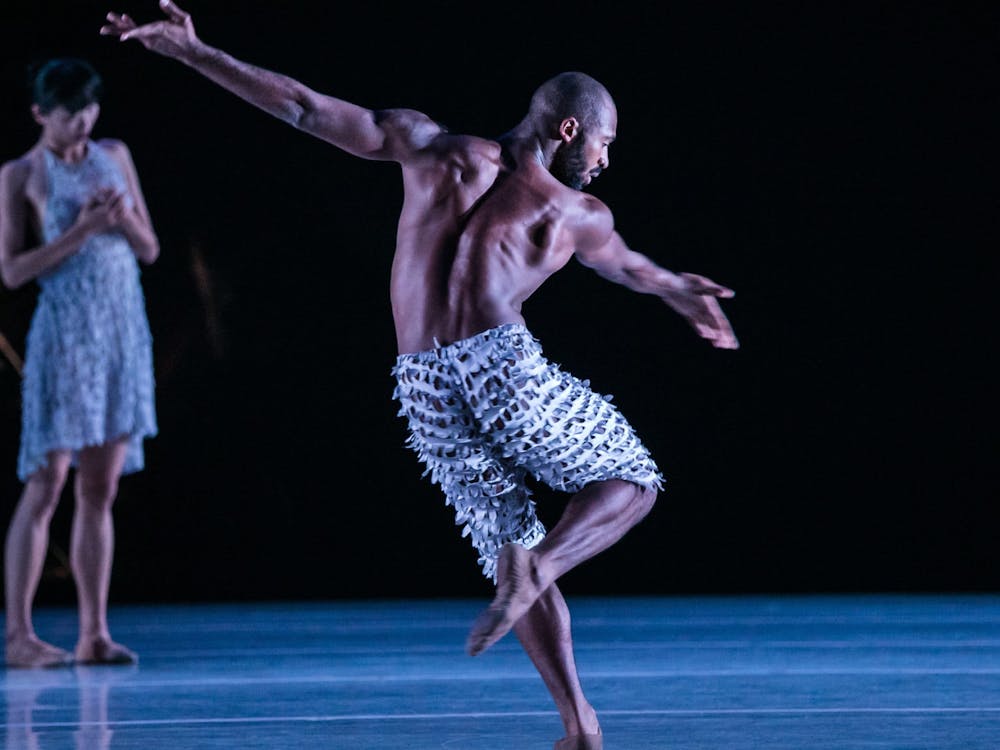Ballet is notable for the physical balance, strength and flexibility dancers need. Ballet dancers spend hours of training to develop these traits, and even some professional football players take ballet classes to improve their balance and prevent injuries. But what kind of energy and emotional intensity can ballet bring to the stage? How does this 15th-century dance form compete with modern forms of art and entertainment? How has it become a modern art form?
On Nov. 15 and 16, Alonzo King’s ballet company, LINES, brought artistic innovation to Duke’s Reynolds Industries Theater. King was trained at the School of American Ballet and is now a distinguished choreographer who works with the Royal Swedish Ballet, Frankfurt Ballet, Hong Kong Ballet and more. He created the LINES company in 1982, and the San Francisco-based company has been performing across the globe ever since.
The performance last weekend was the first of “Ballet Futures,” a series of ballet performances coming to Duke throughout the 2019–20 season, featuring BalletX, the American Ballet Theatre’s (ABT) Studio Company, Les Ballets Trockadero de Monte Carlo (The Trocks) and ABT’s Main Company.
Unlike well-known ballets such as “The Nutcracker” or “Swan Lake,” which use dance to tell a story, LINES presents more conceptual pieces that forgo a linear narrative to emphasize the complexities of humanity.
“The term LINES alludes to all that is visible in the phenomenal world,” King explained on his website. “There is nothing that is made or formed without a line. From vibration or dot to dot it is the visible organization of what we see.”
In the first half of the performance, entitled “Handel,” the company paid tribute to the eponymous 18th-century German composer. The ballet opened in silence, with nothing but the sound of the dancers’ footsteps echoing through the theater. This mysterious quiet was soon filled by a crescendo of baroque music, stage lights and rapid movement. The dancers donned simple yet fantastical costumes, draped in lightweight navy fabrics reminiscent of fairy tale villains.
The company proceeded to impress the audience with an elegant dichotomy between geometric forms and graceful movements; the dancers appeared to simultaneously be cutting and melting through the air, their bodies forming sharp angles as they bounced and glided through space.
Toward the end of “Handel,” the dancers gathered in a position that mimicked a leader preparing his troops for battle, followed by fallen soldiers desperately crawling across the “field.” These dancers then rose and fell in trying to pick each other up — in learning how to live again. This piece exemplified the ballet’s portrayal of the beauty of human interdependence; people are social creatures, and the failure to recognize so leaves us susceptible to isolation.
After intermission, the company presented “Common Ground,” a piece that works in conjunction with the Kronos Quartet to display the artistry of San Francisco. This piece opened with fog and dancers in feathered costumes that reflected the color-changing lights illuminating the stage. Unlike “Handel,” which mirrored the dark, dramatic tension of the Baroque period, “Common Ground” embraced vibrancy and unconditional harmony — maintaining the positivity that has defined San Francisco for generations.
The artists paired fragmented gestures and smooth marches with staccato drum beats and racing violins, bringing an electric energy to the stage. The dancers physically illustrated what is commonly known as the “tension and release” in music; the entire company moved in sync, gravitating toward each other as the music got louder, gradually intensifying the piece. As the music became more chaotic, so did the dancing; the performers rhythmically convulsed and displayed rejections of the body, including choking and regurgitating motions.
This chaos, however, was released with a shift into softer, more tranquil music and warm pink and yellow lighting shining on the dancers. One dancer made a graceful ascent into the air as lavender lights consumed the stage and brought the show to a powerful and satisfying end.
Although this performance was distinctive for its remarkable and fluctuating energy, one could not ignore the extreme strength, practice and determination required to execute the impressive movements and body positions in this ballet. The exceptional contortions of the body in LINES would convince viewers that the human form has no limits — that the body is as flexible as words or music or paint in illustrating stories and conveying emotion.
LINES offered a preview of what is to come this season in “Ballet Futures.” As ballet companies continue to perform at Duke, we must appreciate what ballet as an art form teaches us: the value of dichotomies. Between Baroque darkness and Californian vitality, strength and fluidity and power and vulnerability, ballet exemplifies how opposites complement each other and enhance the performance experience — as they enhance the human experience.
Get The Chronicle straight to your inbox
Signup for our weekly newsletter. Cancel at any time.

